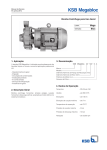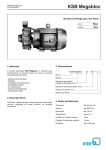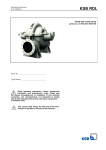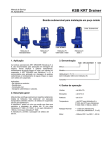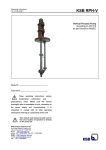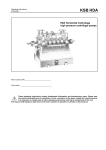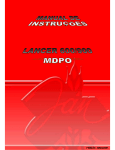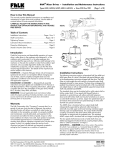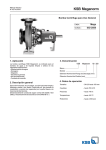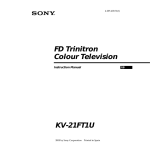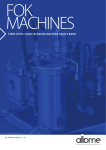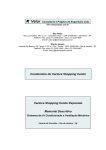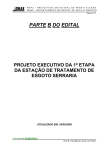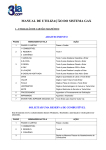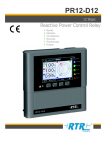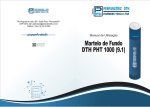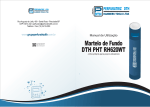Download KSB Megabloc
Transcript
KSB Megabloc Operating Instructions Nº A2744.8E/2 General Service Centrifugal Pump Line : Mega Version: 1. Application 3. Designation The KSB Megabloc pump is designed for pumping clean or turbid liquids and it is used in: - Water supplies for industries Irrigation Circulation of condensates City property installations Air conditioning Cooling services Bloc KSB Megabloc 32 - 125 + 2 . 2 Trade Mark Model / Type Discharge Nozzle Diameter (mm) Nominal Impeller Diameter (mm) Motor Rating (HP) 2. Design Horizontal, single stage, end suction and top centerline discharge, coupled to electric motor on monobloc system. Number of Poles 4. Operating Data Size : DN 25 up to 150 (1” to 6”) Flow : to 2201 gpm (500 m3/h) Head : to 426 ft (130m) Temperature : 194 ºF (90ºC) Maximum suction pressure : 43 psi (3 bar) Maximum discharge pressure : 190 psi (13 bar) Speed : to 3.500 rpm Megabloc 5. Introduction KSB has supplied you with an equipment that has been designed and manufactured with the must advanced technology. Due to its simple and tough construction it will not need much maintenance. With the aim of providing our clients with a satisfactory, trouble free operation, we recommend to install and care our equipment according to the instructions contained in this service manual. This manual has been prepared to inform the user about the construction and operation of our pumps, describing the adequate procedures for handling and maintenance. We recommend that this manual should be handled by the maintenance supervision. This equipment should be used in the operational conditions for which it was selected as to: rate of flow, total head speed, voltage, frequency, temperature of pumped liquid. Place for description of manufacturer datas. Place for description of type and size of the pump. Place for order number. Fig.1 – Nameplate For requests about the product, or when ordering spare parts, please indicate the type of pump and the manufacturing order nº (serial nº). This information can be obtained from the nameplate on the actual pump. If the nameplate is not available, the OP nº is engraved in low relief on the suction flange, and on the discharge flange you may find the impeller diameter. Attention: This manual contains very important instructions and advices. Its careful reading is an obligation before installation, electrical connections, first starting and maintenance. Contents Page Page 1. Application 01 8. Installation 06 2. Design 01 9. Starting 07 3. Designation 01 10. Operation 07 4. Operating Data 01 11. Shutdown Procedure 07 5. Introduction 02 12. Operational Abnormalities and Troubleshooting 08 6. General Information 03 13. Disassembly 09 6.1 Equipment Inspection 03 14. Assembly 09 6.2 Storage 03 15. Exploded View 10 6.3 Description 03 16. Electric Motor Installation and Use Instructions 11 7. Pipings 04 17. Electric Motor Maintenance and Lubrication 11 2 Megabloc 6. General Information 6.1. Equipment Inspection Inspect the equipment as soon as it has been received. Check it with the information contained in packing label and inform immediately the dealer of any irregularities found, such as damaged or lacking parts. 6.2. Storage Protect the KSB Megabloc from physical damages humidity, dust and aggressive environments. 6.3. Description Casing: Single volute, with top centerline discharge in standard assembly, which is also possible in others positions. Suction and discharge may be threaded (BSP) or flanged (ANSI B. 16.1 250 # FF for sizes 40-250, 50-250, 50-315, 65250, 80-250, and ANSI B.16.1 125 # FF for the others sizes). The casing is fitted to the discharge cover (adaptor part with fits, which allow a perfect alignment). The casing is radially split with back-pull-out design, which allows the pump disassembly without dismounting the suction and discharge pipings. Standard material – Cast iron Optional material – Stainless steel Impeller: Radial, single suction, closed type, directly driving by the electric motor shaft. Standard material – Cast iron Optional material – Stainless steel Adaptor / Discharge Cover : Keeps pump casing firmly aligned with the electric motor flange. Standard material – Cast iron Optional material – Stainless steel Mechanical Seal : Standardized for use with water to 194 ºF (90ºC) , as well as for most hydrocarbons. For others temperatures and liquids refers to KSB. Standard material – Carbon/ Stainless steel or Ceramics Stainless steel. Optional material – Tungsten carbide / Tungsten carbide Shaft Protecting Sleeve Elongated, protecting the shaft on the sealing region, which prevents the pumped liquid to get in contact with the shaft. Standard material – Bronze Optional material – AISI 316 Electric Motor: Supplied as an integrating part of the set. Standard with flange and JM/JP shaft end according to NEMA norm. Its ball bearings are dimensioned to withstand radial and axial loads acting over then. The set is supported by the electric motor feet. Protection Degree Insulation Class Service Factor Rotative Speed Phases / Frequency Voltage : TFVE :B : 1.10/1.15 (to 50 hp) 1.00 (60 and 75 hp) : 3,500 rpm / 1,750 rpm : 3/ 60 Hz : 220/380/440/760V 3 Megabloc 7. Pipings The perfect duty of a pump depends on dimensions and correct arrangement of piping to be used. The suction and discharge pipings shall be supported by suitable means. This way , mechanical efforts are prevented to be transfered to pump nozzles. Avoid support pipings on pump nozzles 7.1. Suction Piping The suction piping shall be dimensioned according to the following criterion: Diameter size never minor than the suction nozzle 6.56 ft/s (2 m/s) maximum liquid speed Install piping , so straightest and shortest as possible In case of negative suction , install piping in slope towards the pump. Try to minimize the pressure losses at the suction piping and respective accessories (valves, curves, reductions, strainer, etc.). Avoid the making up of air pockets caused by siphon concentric reducers etc.., when laying out suction piping specially in case of negative suction. 7.2. Discharge Piping The discharge piping shall be dimensioned taking into account the following criterion: a) Economy: Investment of KSB Megabloc Investment of piping and its relevant accessories Amortization time of investment b) Technical 16.4 ft/s (5 m/s) maximum recommended speed. Install a check valve after discharge nozzle. Prevent air pockets making up in piping. If that is not possible the highest piping points shall be provided with an air vent device to facilitate air outlet. 4 Megabloc 7.3. Typical Installation Fig. 2 5 Megabloc 8. Installation A poorly performed assembly will result in operation disturbances, causing vibrations and wears on internal parts. Preferably KSB Megabloc shall be assembled on a concrete foundation or over a metallic base with flat surface on the fastening area. The fastening will be performed through 4 screws on the electric motor feet. NOTE: For pumps with flanged suction and discharge , the pump casing will be equipped with feet. Fastening to base however, shall be performed through the 4 screws on the electric motor feet. 8.1. Installation Availability Before placing KSB Megabloc on installation site, turn its shaft and see if it is turning freely. After fastening and installation of suction and discharge piping , check again if shaft is still turning freely . Be sure that pipings are not transferring stresses to the pump nozzles. A – Horizontal Assembly Fig. 3 6 Megabloc 9. Starting The bellow procedures must be followed to start the KSB Megabloc operation. 9.1. Priming Before starting up it is necessary to fill completely the suction piping and the pump with liquid. This operation is called priming and it can be made by using one of the following methods: • If the liquid level on suction reservoir is above the pump suction nozzle, you only have to open the suction and discharge valves and let the liquid flow by gravity until complete filling of pump. • When the liquid level in suction reservoir is at suction nozzle elevation or bellow it and suction piping is equipped with a foot valve, both pump and piping shall be primed by using one of the following methods: • ¾ Remove plug (part nº 903) and install a priming funnel (with valve) in its place . After opening the suction valve fill with the liquid to the pumped through the priming funnel until filling of pump and suction piping. When the operation is completed , close the funnel valve. ¾ When an external source of pumped liquid is available, a permanent connection piping with valve shall be adapted, as well as provided an air vent also just after discharge nozzle and before any valve, allowing air release. Priming is carried out by opening the external source valve and letting the liquid flows until pour out through the air vent. Once the priming is performed , close the air vent and also the external source valve. Other priming methods may be used depending on the installation location availability . Most of these methods are based on the creation of a differential pressure between suction piping, the pump and the discharge piping, being used mainly when there is not a foot valve available. 9.2. Preparation for Starting • Open totally the suction valve. • Close the discharge valve • Prime the pump and suction piping (see item 9.1). 9.3. Start-up After the above steps have been done, start the motor for a very short time and switch it off observing whether the rotation direction is identical to that one indicated on the pump casing. Once controlled the rotation direction, switch on the motor and let it reach its full speed. Then open slowly the discharge valve. The pump cannot operate with discharge valve closed after the motor reach full speed, for more than few minutes. CAUTION : NEVER OPERATE A DRY PUMP 10. Operation At the start-up the pump mechanical seal may leak a little. Such a leakage should cease after accommodation of sealing surfaces. The pump running should be soft. In case of operation difficulties, refer to item 12. 11. Shutdown Procedure To shutdown the KSB Megabloc the below procedure should be followed: A - Close the valve on discharge side. B - Switch of the electric motor. 7 Megabloc 12. Operation Abnormalities And Troubleshooting 12.1. Abnormalities Abnormalities - Pump does not pump or pumped flow is insufficient - Pump stops discharge after start - Insufficient discharge pressure - Electric motor overloaded - Leakage on mechanical seal - Reduced mechanical seal life - Vibrations / Noises - Overheating Probable Causes 01- 02- 03- 04- 05- 06- 07- 08- 09- 10- 11- 12- 15- 16- 17 01- 02- 03- 04- 05- 06- 07- 08 01- 02- 03- 04- 05- 07- 09- 10- 11- 12- 15- 16- 17 11- 13- 14- 15- 16- 19- 20 12- 18- 19- 20- 22- 24- 25- 26 01- 18- 19- 20- 21- 22- 23- 24- 25- 26 01- 02- 04- 11- 12- 17- 18- 19- 20- 21- 27- 28- 29- 31- 32 01- 02- 03- 10- 13- 18- 19- 20- 27- 30- 32 12.2. Probable Causes 01 02 03 04 05 06 07 08 09 10 11 12 13 14 15 16 17 18 19 20 21 22 23 24 25 26 27 28 29 30 31 32 - The pump has not been primed or priming was poorly done. The installation requires a suction condition over one of the pump (available NPSH is lower than required NPSH). Excessive suction slope. Air pockets in suction piping. Air is leaking into suction piping Suction valve closed or partially opened. Foot valve too small or clogged Suction piping is not sufficiently immersed. Rotation in reverse direction Total head higher than that one informed by occasion of selection. Foreign bodies on impeller . Excessive wear of internal parts. Electric motor operating in two phases. Total head lower than that one informed by occasion of selection. Liquid viscosity is different of the one informed by occasion of selection Liquid density is different of the one informed by occasion of selection. Damaged or worned down impeller Warped shaft. Friction of rotary parts with stationary parts. Damaged or worned down bearings. Misalignment due to forces or expansions of pipings. Mechanical seal assembled incorrectly. Abrasive elements in pumped liquid. Shaft protecting sleeve worned down. Internal misalignment of parts restraint stationary seat to accommodate with mechanical seal rotary seat. Mechanical seal has operated dry. Operation with reduced flows. Set fastening in not sufficiently steady. Lack of lubrication on bearings. Excessive grease on bearings. Impurities on bearings or on lubricant. Oxidation of bearings due to water penetration. 8 Megabloc 13. Disassembly Before starting disassembly of KSB Megabloc identify first in which of the two assembly figures (item 15) it fits. For a better identification we describe bellow both possible disassembly sequences. 13.1. KSB Megabloc up to 15 HP, II Poles and up to 40 HP, IV Poles 1. Remove the 4 screws which are fastening the electric motor to foundation. 2. Remove the screws (900.1) which are fastening the casing (102) on discharge cover (163). 3. Separate the set from the casing. 4. Hold the impeller (230) to keep if from turning and remove impeller screw (906) and the flat gasket (400.3) , so you can remove the impeller. 5. Remove the shaft protecting sleeve (524) together with mechanical seal parts (433) mounted on shaft protecting sleeve. 6. Remove the discharge cover (163) removing screws (901.2) which are fastening it to electric motor (801). 7. Remove the mechanical seal part (433) which is fixed on discharge cover (163). 13.2. KSB Megabloc over 15 HP, II Poles 1. Remove the 4 screws which are fastening the electric motor to foundation. 2. Remove the screws (900.1) which are fastening the casing (102) to adaptor (145). 3. Separate the set from the casing. 4. Hold the impeller (230) to keep if from turning and remove impeller screw (906) and the flat gasket (400.3) , so you can remove the impeller. 5. Remove the shaft protecting sleeve (524) protecting the sleeve. 6. Remove the discharge cover (163) fixed on adaptor (145) . 7. Remove the mechanical seal part (433) fixed on discharge cover. 8. Remove the adaptor (145) removing screws (901.2) which are fixing it to the electric motor. together with mechanical seal parts (433) mounted on shaft 14. Assembly The assembly of KSB Megabloc is the opposite of disassembly already described , but some precautions are necessary: 1. Anoint with some fine oil (SEA 10 or SAE 20) or pure vaseline the mechanical seal contact parts. 2. Clean all pieces. 3. Use a new set of gaskets at each assembly. 4. When placing the flat gasket (400.2) on casing (102) it is advisable, for a better fitting, that some grease or oil is anointed on contact region of casing with gasket. Once finished the assembly, turn the shaft and check if it rotates freely. Otherwise, disassemble the pump and reassemble it. Should the problem remain, refer to nearest authorized dealer. 9 Megabloc 15. Exploded View 15.1. KSB Megabloc with motors up to 15 HP, II Poles and up to 40 HP, IV Poles. 15.2. KSB Megabloc with Motors over 15 HP. II Poles DESIGNATION Volute Casing Adaptor Discharge Cover Impeller Flat gasket Mechanical Seal Shaft Protecting Sleeve Hexagon Head Bolt Threaded Plug Impeller Screw Key PART Nº 102 145 163 230 400.1/2/3 433 524 901.1/2 903.1/2/3 906 940 10 Megabloc 16. Electric Motor Installation And Use Instructions When installing the electric motor, follow these important recommendations carefully: • Rated voltage and frequency • Environmental temperature not higher than 104ºF (40ºC) 1) • Location at shade • Altitude not over 3,280 ft (1.000 m) 1) • Correct power supply wire gauge. • Thermal protection switch application In order to motor operate satisfactorily and with total efficiency, it is indispensable that these and the following conditions are carefully met: 16.1 – The motor should perform satisfactorily with nominal load, provided that percent voltage variations are not over ± 10% of the rated voltage. In the same way, the allowable frequency variation is 5% of nominal frequency . Sum of frequency and voltage variations shall not be over 10%. 16.2 - The temperature measurement shall be performed preferably by the method of winding electric resistance variation. 16.3 - Besides the temperature and environment recommendations it is very important to note that normal motors should not be installed at an altitude higher than 3,280 ft ( 1,000 m) above sea level, and location in the shadow shall be preferably complied with. 1) 16.4 - It is very important to meet the correct electric power supply, by using the gauges recommended for connection cables . When proceeding to connection of the terminals be sure of the network voltage and frequency. Check whether motor corresponds to these characteristics , then complete connection , in accordance with the scheme printed on the nameplate. 16.5 - It is recommended that a switch with thermal protection is applied, thus preventing possible burns because of lack of phase, overload or excessive voltage and frequency fluctuation. Check if current and rotation with load do not deviate from the values mentioned on nameplate, which can be verified by means of electric measurement through a volt-ammeter, to prevent overload and other abnormalities which could impair the motor life. Note: 1) In case of altitude higher than 3,280 ft (1,000 m) and or temperature over 104ºF (40º C) refer to KSB. 17. Electric Motor Maintenance And Lubrication We recommend the periodical checking of switch contacts preventing worst consequences caused by oxidation, or bad contact of elements. The electric motor bearings are supplied with sufficient grease for a long operation period. According to the size and design , the motors may be provided with lubrication holes or with shielded bearings. To relubrify use tables 2 and 3. CAUTION DO NOT OVERLUBRIFY Excess grease is more hazardous than lack of grease for bearings. 11 Megabloc 17.1 Grease Type Manufacturer Type ESSO SHELL PETROBRÁS ATLANTIC IPIRANGA TEXACO Beacon 2 Alvania R2 Lubrax GM Industrial A2 Litholine 2 Isaflex EP2 Multifak 2 17.2 Relubrication Interval Power (HP) 2,0 to 3,0 4,0 to 7,5 10 to 25 30 to 40 Interval (h) 8,000 6,000 4,500 3,000 Note: The information in this manual can be alterated by KSB Bombas Hidráulicas S.A., without previous notice. 12 A2744.8E/2 11.09.2007 Megabloc KSB Bombas Hidráulicas SA Rua José Rabello Portella, 400 Várzea Paulista SP 13220-540 http://www.ksb.com Brazil phone.: 55 11 4596 8500 Fax: 55 11 4596 8580 SAK – KSB Customer Service e-mail: [email protected] Fax: 55 11 4596 8656 13













